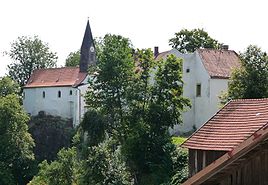Ranfels
|
Ranfels
Zenting municipality
Coordinates: 48 ° 46 ′ 0 ″ N , 13 ° 16 ′ 2 ″ E
|
|
|---|---|
| Height : | 449 m |
| Incorporation : | January 1, 1972 |
| Postal code : | 94579 |
| Area code : | 09907 |
|
Ranfels Castle and Parish Church
|
|
Ranfels is a parish village , a district and former Hofmark in the municipality of Zenting in the Lower Bavarian district of Freyung-Grafenau .
location
The place is located on a spur of the terrain above the Ginghartinger Bach about 2.5 kilometers west of Thurmansbang and about the same distance southeast of Zenting. The highest point rises at 465 meters to around 90 meters above the bottom of the brook on deeply buried granite .
history
The history of the place has always been closely linked to the manor house of the same name. The Counts of Formbach or the Counts of Neuburg are believed to be the builders . In 1207 the owners were the bishops of Passau , who enfeoffed the nobles von Hals with it in 1243 . These conferred the rule on as an after-fief . From 1259 to 1262 the brothers Albertus and Fridericus de Ranvels lived here. After the extinction of Halser took over in 1375, the Landgrave of Leuchtenberg Ranfels, 1417 it came through sale to Etzel I. in the possession of the Imperial Count of Ortenburg . In 1438 Etzel sold it to Duke Heinrich von Niederbayern . The castle was destroyed during the Landshut War of Succession and then rebuilt. In 1517 it was taken over by the knight Johann von Dachsberg zu Asbach. In 1518 he set up the castle chaplaincy with the associated castle chapel and fundamentally rebuilt the castle by 1520.
In 1784, the castle was bought by the Dachsbergers at the St. Anna monastery in Munich . From there, Ranfels was administered by its own keeper until the Bavarian state bought it in 1833. He removed and sold many components and converted the remaining buildings into the palace chaplain 's apartment . In the year of the first Bavarian census in 1840, the Ranfels community comprised 72 families and 332 people. 32 families with 72 members and 70 people belonging to the servants lived exclusively from agriculture and forestry.
In 1845 the castle beneficiary was converted into a curate beneficiary due to the long distance to the parish of Schöllnach and its own cemetery was built. The former castle chapel fundamentally changed its appearance through enlargements and additions in 1767 and 1824 (other information: 1842). In 1855 the village had 22 houses. In 1873 the Ranfels volunteer fire department was founded. In 1923 it was elevated to a parish . The municipality of Ranfels had 437 inhabitants in 1905, 467 in 1933, 471 in 1939 and only 345 in 1970 after a drastic population decline since the end of the 1950s. The center of Ranfels itself hardly changed and in 1970 had 131 residents. Far away from traffic and industry and a lack of tourism are the causes of these population losses.
The number of agricultural and forestry holdings, on the other hand, increased steadily to 78 in 1971, but at the expense of the size of the property: While in 1840 the largest farm had 84.5 hectares of land, there were no more farms with more than 20 hectares in 1970 . In 1970 the share of those employed in agriculture and forestry was 55.2%. On January 1, 1972, Ranfels was incorporated into the greater Zenting as part of the regional reform in Bavaria .
Attractions
From the former castle, the gate building with adjoining residential buildings in the area of the outer bailey are still preserved. The inner courtyard is accessible. The parish church of St. Pankratius, which emerged from the castle chapel, stands on the site of the former main castle. It has baroque figures and modern furnishings.
Soil monuments
societies
- Ranfels Volunteer Fire Department
- Ranfels Women's Association
- Ranfels Warrior and Soldier Association
- Ranfels village community
- Ranfels bowling club
- KLJB Ranfels
literature
- Joseph Klämpfl: The former Schweinach and Quinzingau. A historical-topographical description , 1855, reprint 1993, Neue Presse Verlags-GmbH, Passau, ISBN 3-924484-73-2
- Donatus Moosauer, Günther Michler, Ulrich Pietrusky: Niederbayern - rediscovered in flight , Morsak Verlag, Grafenau, 2nd edition 1982, ISBN 3-87553-135-3
Individual evidence
- ^ Wilhelm Volkert (ed.): Handbook of Bavarian offices, communities and courts 1799–1980 . CH Beck, Munich 1983, ISBN 3-406-09669-7 , p. 473 .

